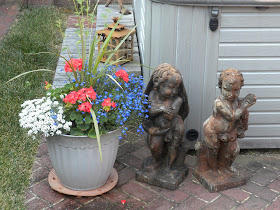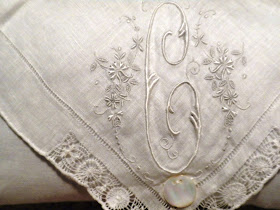With summer gatherings in full swing, I'm sharing a few of my favorite collected recipes that have gone over very well with my family gatherings. Whether you're the host, or you're taking a dish to someone else's gathering, these are all good ones that got rave reviews. I've included links to the recipes I found, and I sometimes alter them with what's on hand in my pantry.
Salad #1: Greek Orzo Salad
I have made this salad MANY times (I could eat the entire bowl myself!). It's a pretty salad, and takes about 1 hr from start to finish to make. :)
Salad #2 (Super Easy - they'll think you made it!): Wal-Mart Deli Amish Potato Salad and Wal-Mart Deli Original Potato Salad. Just mix equal amounts (images are distorted) of each kind together for a "just right' combination of onion (original) and sweet & mustard-y (Amish) flavor. Even my husband likes it! BAM!
Salad #3 (Easy, but I add ingredients): Wal-Mart Macaroni Salad. I add chopped cucumber, celery & green pepper to mine, for taste. It's a little too runny on its own, and I would advise you to drain a bit of the juice.
Dessert #1: Tuxedo Brownie Cups
These are TO DIE FOR! You can garnish them to suit your holiday:
Tuxedo brownie Cups 4th of July flag garnish (above): blueberries and strawberries, and one row no garnish.
Dessert #2: Mini Sugar Cookie Fruit Cups
Salad #1: Greek Orzo Salad
I have made this salad MANY times (I could eat the entire bowl myself!). It's a pretty salad, and takes about 1 hr from start to finish to make. :)
You can tailor the ingredients (above) to your own liking for the Greek Orzo salad.
Notes for Greek Orzo salad:
- Orzo is just another type of pasta, and can be in any grocery, alongside all other pastas. It looks a lot like rice in its shape.
- One major change I made to this recipe, consistently, is I increased the dressing by 1.5 times the amount of ingredients called for; otherwise it was a little too dry for my taste. I calculated the amounts and wrote it on my printed sheet of the recipe so I wouldn't have to repeat the math exercise.
- I substituted honey dijon mustard for dijon (it's what I had on hand).
Salad #2 (Super Easy - they'll think you made it!): Wal-Mart Deli Amish Potato Salad and Wal-Mart Deli Original Potato Salad. Just mix equal amounts (images are distorted) of each kind together for a "just right' combination of onion (original) and sweet & mustard-y (Amish) flavor. Even my husband likes it! BAM!
Salad #3 (Easy, but I add ingredients): Wal-Mart Macaroni Salad. I add chopped cucumber, celery & green pepper to mine, for taste. It's a little too runny on its own, and I would advise you to drain a bit of the juice.
I substitute Kraft's Light Balsamic Vinaigrette Dressing for Balsamic Vinegar for a little more oomph.
Dessert #1: Tuxedo Brownie Cups
These are TO DIE FOR! You can garnish them to suit your holiday:
Tuxedo brownie Cups 4th of July flag garnish (above): blueberries and strawberries, and one row no garnish.
Dessert #2: Mini Sugar Cookie Fruit Cups
These were great at Easter, and my family wants a repeat performance because they were SO GOOD, but they were a little more labor-intensive than I feel like doing for the 4th (they start out easy with Pillsbury prepared sugar cookie dough). They would also make great baby or wedding shower desserts.
My tips for the mini sugar cookie mini fruit cups: (I read all the comments on this blog from which I linked the recipe beforehand, and compiled my own version as a result):
- I used paper cup liners for my mini pans (peeled & discarded before assembling). Some of them fell apart as I did this ("to the victor goes the spoils" was my theory).
- I made the cookie cups, and filling (separate from each other) 1 day ahead & kept refrigerated in air-tight container until ready to assemble. I made the filling as suggested, and propped it upright in my fridge, taping the freezer bag in a cone shape so the filling would be ready to squeeze when I was ready.
- I filled the fruit cups with the filling a few hours before my get-together, refrigerated again, and garnished with the already cut fruit just before placing on serving tray.
I made these last summer, and they were a hit - light & tart, the way lemon should be! I believe I will make these again for the 4th, as an homage to Ms. Deen and her current public struggle she is dealing with.
Finished blossom photo above not my own - from Crazy About Cakes blog link recipe.
My notes on the lemon blossoms recipe:
- The photo above of the ingredients shows the larger (4.3 oz) box of cook & serve pudding - it's what I had on hand (not instant). I just used ~ 3.4 oz., as called for (just the box contents, not all the added ingredients).
- I used approximately 2 1/2 lemons for this recipe (it calls for 1 for the zest, but for the 1/3 C lemon juice, I used the real thing, freshly squeezed).
- The finished photo shows, but the recipe does not explicitly say, the cups are depressed for the glaze to gather and puddle. To do this, gently depress the cake cups with the back of a spoon minutes after pulled from the oven (baked).
Happy Gathering, y'all! And don't forget the deviled eggs, fruit & veggie trays! Not to mention the iced tea! All are summertime crowd pleasers!
Sharing with:
Fun in the Sun Link Up
Common Ground Be Inspired #146
Sharing with:
Fun in the Sun Link Up
Common Ground Be Inspired #146





























































